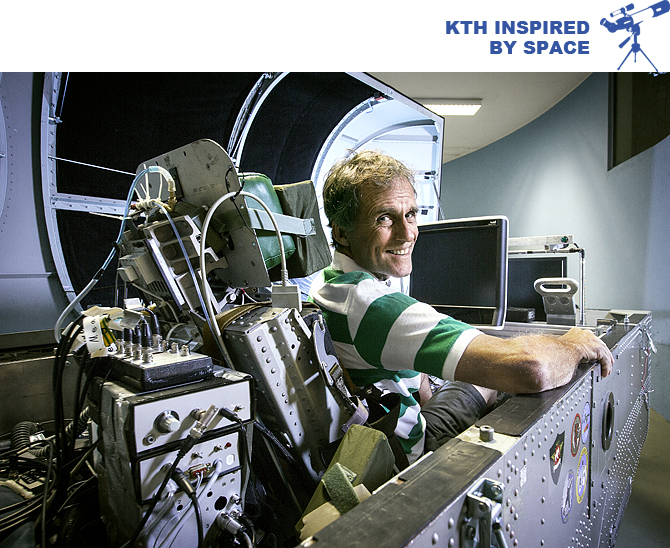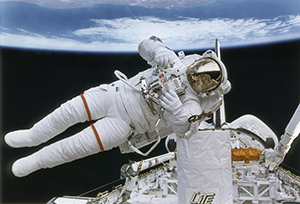
What happens to the body in space?
How does prolonged bed rest or weightlessness affect your body? Professor Ola Eikens research team is studying the effects of life in space on circulation, muscles and metabolism.
"This research is driven by futuristic ideas for putting people on Mars, but ordinary patients with health problems due to inactivity can also benefit from our findings, says Eiken, a physician, researcher and director of the Swedish Aerospace Physiology Centre at KTH.

In environmental physiology, researchers are studying how people react in extreme environments, such as when air pressure changes at high altitudes and in the depths of the sea. It can also apply to temperature variations during polar expeditions, or wearing heavy protective equipment in the tropical heat.
The research, which has long been mainly focused on divers, combat pilots and climbers, has in recent years taken aim at the astronaut's environment.
There are few teams who are able to send people into space; but from the Earth, Eiken's research is helping among others the European Space Agency (ESA) to customize and run tests on astronauts working on the International Space Station.
In August 2015 Eikens research team wrapped up work with two experimental series. In one study, the researchers examined the effects on the muscles, bones and other organs in combination with low oxygen content and inactivity.
The second series of experiments examined how blood vessel function is affected by inactivity and the (simulated) weightlessness.
The latter project is about how best to prevent blood vessels from losing their elasticity at zero gravity, or by prolonged bed rest.
"We have found that the blood vessels can be pressure exercised. There is already on a small scale in space, through a box with negative pressure where astronauts can manipulate the pressure in their veins," he says.
"This we have now managed to prove through terrestrial tests, where we studied the vessels," he says. The findings show that a bedridden and motionless person who pressure exercises vessels in the legs for three weeks, then all of the leg's blood vessels arteries, arterioles and veins, are exercised and blood vessels' elasticity be maintained.
"With simple means, one can retain the function of body parts," Eiken says.
Scientists use the words often used by ground-based simulation models to simulate space conditions. In this type of test work used the method "bedrest".
The test subjects must remain still a long time - usually for 3-5 weeks.
The studies are performed on volunteers, who are fully healthy test subjects. Eiken says ad campaigns easily find people who want to participate.
"The Bedrest Model implies that people are put to bed, horizontally or with the head tilted slightly downward, to mimic the redistribution of blood volume and blood vessel pressure that occurs in microgravity," he explains.
One problem that they have studied is that astronauts returning to Earth initially cannot stand up without fainting, something that also applies to people who have been bedridden for a long time, he says. That is partly because the blood vessels in the lower part of the body become so slackened that the blood literally falls down in the body, from the head downwards.
When man stands up, it creates in a normal circumstances pressure variations in the blood vessels through gravity. This means that the pressure in the vessels rises below the heart, while the pressure in the arteries above the heart falls.
Something that has been shown to happen in space, and from long bed rest, is that the blood vessels in the lower half of the body lose elasticity; and when the person returns to normal gravity, the blood is redistributed to the lower body. Therefore, it becomes difficult to maintain normal blood pressure in the above the heart."
"Back in the normal environment or with movement again, the person has too little blood volume and too low blood pressure in the central arteries, and therefore liable to faint when he or she is standing. The rehabilitation takes time, Eiken says.
Research shows that after five weeks of bed rest, five weeks of rehabilitation training is required before blood volume returns to a normal level.
"Another problem that arises in both space flight and after long-term bed rest is the atrophy of the muscles," he says. "Few recall that many important muscles are postural, meaning they are mainly used when we stand up. For example, we burden knee extensors and other leg muscles a lot when we are standing and walking."
But when unburden these muscles, the body adapts and muscles atrophy and weaken, and it also becomes difficult for the nerves to activate muscles. They simply stop working. To counter this, it is important that astronauts and bedridden patients exercise postural muscles as much as possible, he says.
Katarina Ahlfort

